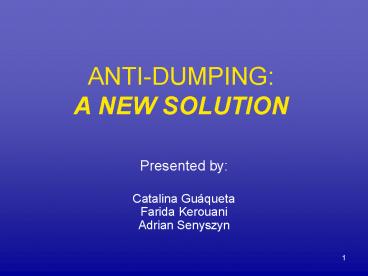ANTI-DUMPING: A NEW SOLUTION - PowerPoint PPT Presentation
1 / 19
Title:
ANTI-DUMPING: A NEW SOLUTION
Description:
ANTI-DUMPING: A NEW SOLUTION Presented by: Catalina Gu queta Farida Kerouani Adrian Senyszyn Anti-Dumping Explanation Proposal Broader Implications Futures ... – PowerPoint PPT presentation
Number of Views:60
Avg rating:3.0/5.0
Title: ANTI-DUMPING: A NEW SOLUTION
1
ANTI-DUMPING A NEW SOLUTION
- Presented by
- Catalina GuáquetaFarida KerouaniAdrian Senyszyn
2
Anti-Dumping
- Explanation
- Proposal
- Broader Implications
- Futures Challenges
- Bibliography
3
What is Anti-Dumping?
- Article VI of GATT 1994
- A product is said to be dumped when its export
price is less than its normal value, that is less
than the sale of a like product in the domestic
market in the exporting country.
4
Anti-Dumping Litigation
- World Trade Organization
- Countries are responsible for bringing a case to
the WTO Dispute Resolution System. - U.S. Court of International Trade
- Commerce Department determines if anti-dumping
occurred. - International Trade Commission (ITC) determines
if material injury occurs.
5
Anti-Dumping Globally
- Anti-dumping measures taken by WTO members have
increased from 129 in 1994 to 236 in 2000 83. - Dec. 2000 - 1119 anti-dumping measures in place
globally. - New users Argentina, India, Brazil, South
Africa. - Traditional users Canada, U.S., European Union,
Australia, Mexico. - Most affected industries Metal, Chemical,
plastic, textiles, machinery and equipment,
agriculture and food.
6
Most Affected Sectors
Source WTO Secretariat, Rules Division
Anti-dumping Database
7
Anti-Dumping Measures
8
Statistics (January - June 2002)
- 30 less investigations for this period in
comparison with last year at the same period of
time. - 37 cases initiated by developed countries and 63
by developing countries. - So far we have the similar trend for steel and
chemical sectors. - Out of 22 AD initiations in the US 16 involved
metal products.
9
U.S. As Complainant
- 1 of 59 complaints made by the U.S. were related
to anti-dumping. - Case Mexico Anti-Dumping Duties on High
Fructose Corn Syrup - U.S. prevailed in litigation.
10
U.S. As Respondent
- 7 of 69 cases that have been brought against the
U.S. are related to anti-dumping. - Case lost Anti-dumping Steel plate from India.
- 6 of 8 cases in consultations are Anti-dumping
related.
11
Impact of Anti-Dumping Laws
- Pros
- Prevents Monopolies
- Protects Vulnerable Industries
- Allows Firms Time to Compete
- Preserves Jobs
- Cons
- Against Free Trade Concept
- Trade Barrier Lowers Economic Growth
- Distorts the Market
- Protects Firms from Competition
- Hurts Consumers
12
Proposal
- Reform Anti-dumping procedure in the U.S.
- Negotiate minor changes to the WTO Anti-dumping
Agreement.
13
Reform the U.S. Anti-Dumping Law
- Department of Commerce must review the concept of
anti-dumping. - Review the methodology of anti-dumping.
- ITC must define material injury and be a more
partial judge. - Material injury is broad and subject to
interpretation. - Congress must ensure that the ITC is cognizant of
WTO negotiated agreements.
14
Changes to WTO Agreement
- Penalize WTO members for abuse of anti-dumping
law. - Amend article 9, Imposition and Collection of
Anti-Dumping Duties - Negotiate the industry specific, incremental
decrease of anti-dumping laws globally. - Revise article 11, Duration and Review of
Anti-Dumping and Price Undertakings. - Tie in to a compromise on IPR agreements, or
other U.S. interests.
15
Stakeholders
- In Favor
- Consumers
- Exporters
- WB/IMF
- Economists
- Regional Agreements (NAFTA)
- Against
- US currently protected industries
- US Labor Unions (AFL/CIO)
- Countries who want to protect their domestic
market
16
Benefits for the U.S.
- Reduce the number of cases brought against the
U.S. - U.S. wins as a Complainant, and loses as a
Respondent. - Better defense in anti-dumping cases.
- U.S. law closer to WTO agreements.
- Hold other nations accountable.
17
Broader Implications
- Increase competition, which will increase
productivity and efficiency. - Greater economic prosperity for all WTO members.
- Lower prices for consumers.
- Higher national income.
18
Future Challenges
- Negotiating a change to WTO anti-dumping
agreements. - Altering the Dispute Settlement System to award
damages. - Convincing the American public that reform is
critical for continuing U.S. success.
19
Bibliography
- 1 Harvard International Review. National
Sovereignty in the World Trading System. Winter
2001. - The Economist. Our Law, Your Law. June 27, 2002
- Association for Consumer Research. Global Trade
Policy Agenda for Change. September/October - 2001.
- 4 President George W. Bush. Remarks by The
President at Signing of the Trade Act of 2002.
August 6, - 2002.
- Chemical Week. Trade Barriers Start to Fall
Following WTO Entry. September 4, 2002. - 6 Director General Supachai Panitchpakdi.
Trade and Sustainable Development The Doha
Development - Agenda. Johannesburg, South Africa.
September 3, 2002. - The Financial Times. Playground Rules that
Promote Protectionism. September 3, 2002. - The Economist. The Dumping Dilemma. May 30,
2002.































